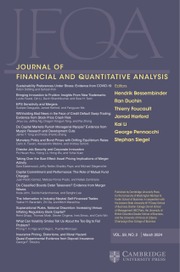Article contents
ETFs, Creation and Redemption Processes, and Bond Liquidity
Published online by Cambridge University Press: 22 April 2024
Abstract
We examine a link between bond exchange-traded fund (ETF) creation and redemption processes and the underlying bond market liquidity. Using daily creation and redemption data, we find that including a bond in a creation or redemption basket has a favorable impact on the bond’s liquidity for both high-yield and investment-grade markets. The improvement in liquidity persists during times of market stress with this impact being stronger for redemptions than creations. Our results suggest that ETF mispricing arbitrage explains the improvement in bond liquidity. However, we also find evidence that transaction costs and bond inventory management limit the ETF arbitrage.
- Type
- Research Article
- Information
- Copyright
- © The Author(s), 2024. Published by Cambridge University Press on behalf of the Michael G. Foster School of Business, University of Washington
Footnotes
The authors thank Doug Blackburn, Steve Laipply, Ananth Madhavan, Josh Penzner, and Kumar Venkataraman for many valuable insights. We thank Christopher Reilly (the referee) and Jennifer Conrad (the editor) for their detailed helpful comments. We are responsible for any remaining errors.
References
- 2
- Cited by


